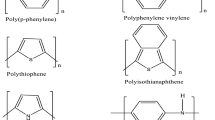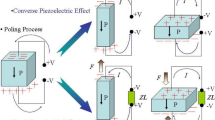Abstract
The demand of self-powered electronic devices has stimulated a great interest in daily life. To fulfill this, thrust researchers are engaged to develop different piezoelectric self-powered-based devices. The piezoelectricity is broadly dependent on the electroactive phase of the polymer structure. Herein, lead-free potassium sodium niobate (KNN) nanorods-incorporated PVDF polymer-based nanocomposite films have been developed wherein KNN nanorods have been surface-modified by three diverse surface modifiers such as 3-aminopropyltrimethoxysilane (APS), polyaniline (PANI) and polyvinylpyrrolidone (PVP) for resolving the agglomeration problem of the nanorods and to look into their effect on the microstructural growth including nucleation of polar crystals. The nanocomposite films have been developed simply by solution cast method. The growth of electroactive phases (β and γ) of the PVDF polymer has been observed to be improved significantly by incorporation of surface-modified KNN nanorods. The calculated beta fraction (F(β)) and gamma fraction (F(γ)) as calculated by the FTIR spectrum (98% and 99%) are maximum for the silane- and PVP-modified KNN nanorods-incorporated PVDF polymer, because of the higher molecular weight and homogeneous distribution of the nanorods throughout the PVDF matrix. The total crystallinity evaluated by XRD patterns, specifically β crystal part for the surface-modified KNN nanorods-based film, has been improved (17% for pure PVDF, 45% for untreated KNN-based film and more than 50% for the surface-modified KNN-based films). The remnant polarization values are also remarkably higher (0.49 μC/cm2 for silane, 0.022 μC/cm2 for PVP and 0.015 μC/cm2 for PANI-modified KNN nanorods-based composites, respectively) for surface-modified KNN nanorods-based composite with contrast to pure PVDF (0.001 μC/cm2) and untreated KNN-based film (0.002 μC/cm2). The dielectric constant values for modified KNN nanorods-incorporated PVDF polymer composites have also been demonstrated as substantial enhancement which are 68, 71 and 70, respectively, for silane-, PANI- and PVP-modified samples, whereas the values are 2 and 38 for pure PVDF and untreated KNN-based films. This study clearly defines that the selection of a suitable surface modifier (interface) can play a noteworthy role in exploitation of excelling electroactive phases of PVDF to the maximum extent to enhance its dielectric, ferroelectric as well as piezoelectric response with low level of loading.










Similar content being viewed by others
References
Hoque NA, Thakur P, Roy S et al (2017) Er3+/Fe3+ stimulated electroactive, visible light emitting, and high dielectric flexible PVDF film based piezoelectric nanogenerators: a simple and superior self-powered energy harvester with remarkable power density. ACS Appl Mater Interfaces 9:23048–23059. https://doi.org/10.1021/acsami.7b08008
Fan FR, Tang W, Wang ZL (2016) Flexible nanogenerators for energy harvesting and self-powered electronics. Adv Mater 28:4283–4305. https://doi.org/10.1002/adma.201504299
Prabakaran K, Mohanty S, Nayak SK (2014) Influence of surface modified TiO2 nanoparticles on dielectric properties of PVdF–HFP nanocomposites. J Mater Sci Mater Electron 25:4590–4602. https://doi.org/10.1007/s10854-014-2209-3
Chen X, Li C, Grätzel M et al (2012) Nanomaterials for renewable energy production and storage. Chem Soc Rev 41:7909–7937. https://doi.org/10.1039/c2cs35230c
Teka A, Bairagi S, Shahadat M et al (2018) Poly(vinylidene fluoride) (PVDF)/potassium sodium niobate (KNN)—based nanofibrous web: a unique nanogenerator for renewable energy harvesting and investigating the role of KNN nanostructures. Polym Adv Technol 29:2537–2544. https://doi.org/10.1002/pat.4365
Anton SR, Sodano HA (2007) A review of power harvesting using piezoelectric materials. Smart Mater Struct 16:R1–R21. https://doi.org/10.1088/0964-1726/16/3/R01
Lin Z-H, Yang Y, Wu JM et al (2012) BaTiO3 nanotubes-based flexible and transparent nanogenerators. J Phys Chem Lett 3:3599–3604. https://doi.org/10.1021/jz301805f
Wang Y, Furlan R, Ramos I, Santiago-Aviles JJ (2004) Synthesis and characterization of micro/nanoscopic Pb(Zr0.52Ti0.48)O3 fibers by electrospinning. Appl Phys A Mater Sci Process 78:1043–1047. https://doi.org/10.1007/s00339-003-2152-2
Wu L, Yuan W, Hu N et al (2014) Improved piezoelectricity of PVDF-HFP/carbon black composite films. J Phys D Appl Phys 47:135302. https://doi.org/10.1088/0022-3727/47/13/135302
Chinya I, Sen S (2017) Improved dielectric and touch sensing performance of surface modified zinc ferrite (ZF)/polyvinylidene fluoride (PVDF) composite. Sens Actuators A Phys 267:301–309. https://doi.org/10.1016/j.sna.2017.10.031
Niu Y, Yu K, Bai Y et al (2015) Fluorocarboxylic acid-modified barium titanate/poly(vinylidene fluoride) composite with significantly enhanced breakdown strength and high energy density. RSC Adv High Energy Density 5:64596–64603. https://doi.org/10.1039/C5RA09023G
Li JY, Zhang L, Ducharme S (2007) Electric energy density of dielectric nanocomposites. Appl Phys Lett 90:1–4. https://doi.org/10.1063/1.2716847
Li J, Claude J, Norena-Franco LE et al (2008) Electrical energy storage in ferroelectric polymer nanocomposites containing surface-functionalized BaTiO3 nanoparticles. Chem Mater 20:6304–6306. https://doi.org/10.1021/cm8021648
Rong MZ, Zhang MQ, Ruan WH (2006) Surface modification of nanoscale fillers for improving properties of polymer nanocomposites: a review. Mater Sci Technol 22:787–796. https://doi.org/10.1179/174328406x101247
Tan F, Qiao X, Chen J, Wang H (2006) Effects of coupling agents on the properties of epoxy-based electrically conductive adhesives. Int J Adhes Adhes 26:406–413. https://doi.org/10.1016/j.ijadhadh.2005.06.005
Xu K, Li J, Lv X et al (2016) Superior piezoelectric properties in potassium-sodium niobate lead-free ceramics. Adv Mater 28:8519–8523. https://doi.org/10.1002/adma.201601859
Wang X, Wu J, Xiao D et al (2014) Giant piezoelectricity in potassium-sodium niobate lead-free ceramics. J Am Chem Soc 136:2905–2910. https://doi.org/10.1021/ja500076h
Wu J, Xiao D, Zhu J (2015) Potassium–sodium niobate lead-free piezoelectric materials: past, present, and future of phase boundaries. Chem Rev 115:2559–2595. https://doi.org/10.1021/cr5006809
Saito Y, Takao H, Tani T et al (2004) Lead-free piezoceramics. Nature 432:84–87
Shrout TR, Zhang SJ (2007) Lead-free piezoelectric ceramics: alternatives for PZT? J Electroceram 19:111–124. https://doi.org/10.1007/s10832-007-9047-0
Egerton L, Dillon DM (2018) Piezoelectric and dielectric properties of ceramics in the system potassium—sodium niobate. J Am Ceram Soc 42:438–442. https://doi.org/10.1111/j.1151-2916.1959.tb12971.x
Bairagi S, Ali SW (2019) A unique piezoelectric nanogenerator composed of melt-spun PVDF/KNN nanorods based nanocomposite fibre. Eur Polym J 1:2. https://doi.org/10.1016/j.eurpolymj.2019.04.043
Liu H, Hu C, Wang ZL (2006) Composite-hydroxide-mediated approach for the synthesis of nanostructures of complex functional-oxides. Nano Lett 6:1535–1540. https://doi.org/10.1021/nl061253e
Hu Y, Gu H, Hu Z et al (2008) Controllable hydrothermal synthesis of KTa1−xNbxO3 nanostructures with various morphologies and their growth mechanisms. Cryst Growth Des 8:832–837. https://doi.org/10.1021/cg070230q
Dolhen M, Mahajan A, Pinho R et al (2015) Sodium potassium niobate (K0.5Na0.5NbO3, KNN) thick films by electrophoretic deposition. RSC Adv 5:4698–4706. https://doi.org/10.1039/c4ra11058g
Weigel C, Kellner R (1989) FTIR-ATR-spectroscopic investigation of the silanization of germanium surfaces with 3-aminopropyltriethoxysilane. Fresenius’ Zeitschrift für Anal Chemie 335:663–668. https://doi.org/10.1007/BF01204067
Shahabuddin S, Sarih NM, Mohamad S, Ching JJ (2016) SrTiO3 nanocube-doped polyaniline nanocomposites with enhanced photocatalytic degradation of methylene blue under visible light. Polymers (Basel) 8:27. https://doi.org/10.3390/polym8020027
Shahmiri M, Ibrahim NA, Yunus WMZW et al (2013) Synthesis and characterization of CuO nanosheets in polyvinylpyrrolidone by quick precipitation method. Adv Sci Eng Med 5:193–197. https://doi.org/10.1166/asem.2013.1227
Kobayashi M, Tashiro K, Tadokoro H (1975) Molecular vibrations of three crystal forms of poly(vinylidene fluoride). Macromolecules 8:158–171. https://doi.org/10.1021/ma60044a013
Nunes-Pereira J, Sencadas V, Correia V et al (2015) Energy harvesting performance of BaTiO3/poly(vinylidene fluoride–trifluoroethylene) spin coated nanocomposites. Compos Part B Eng 72:130–136. https://doi.org/10.1016/j.compositesb.2014.12.001
Salimi A, Yousefi AA (2003) FTIR studies of β-phase crystal formation in stretched PVDF films. Polym Test 22:699–704. https://doi.org/10.1016/S0142-9418(03)00003-5
Foster FS, Member S, Harasiewicz KA, Sherar MD (2000) A history of medical and biological imaging with polyvinylidene fluoride (PVDF) transducers. IEEE Trans Ultrason Ferroelectr Frequency Control 47:1363–1371
Martins P, Lopes AC, Lanceros-Mendez S (2014) Electroactive phases of poly(vinylidene fluoride): determination, processing and applications. Prog Polym Sci 39:683–706. https://doi.org/10.1016/j.progpolymsci.2013.07.006
Sencadas V, Gregorio Filho R, Lanceros-Mendez S (2006) Processing and characterization of a novel nonporous poly(vinilidene fluoride) films in the β phase. J Non Cryst Solids 352:2226–2229. https://doi.org/10.1016/j.jnoncrysol.2006.02.052
Sengupta D, Kottapalli AGP, Chen SH et al (2017) Characterization of single polyvinylidene fluoride (PVDF) nanofiber for flow sensing applications. AIP Adv 7:105205. https://doi.org/10.1063/1.4994968
Thakur P, Kool A, Bagchi B et al (2015) In situ synthesis of Ni(OH)2 nanobelt modified electroactive poly(vinylidene fluoride) thin films: remarkable improvement in dielectric properties. Phys Chem Chem Phys 17:13082–13091. https://doi.org/10.1039/c5cp01207d
Thakur P, Kool A, Bagchi B et al (2015) The role of cerium(iii)/yttrium(iii) nitrate hexahydrate salts on electroactive β phase nucleation and dielectric properties of poly(vinylidene fluoride) thin films. RSC Adv 5:28487–28496. https://doi.org/10.1039/c5ra03524d
Choi SS, Lee YS, Joo CW et al (2004) Electrospun PVDF nanofiber web as polymer electrolyte or separator. Electrochim Acta 50:339–343. https://doi.org/10.1016/j.electacta.2004.03.057
Satapathy S, Pawar S, Gupta PK, Varma KBR (2011) Effect of annealing on phase transition in poly(vinylidene fluoride) films prepared using polar solvent. Bull Mater Sci 34:727–733. https://doi.org/10.1007/s12034-011-0187-0
Awanis Hashim N, Liu Y, Li K (2011) Stability of PVDF hollow fibre membranes in sodium hydroxide aqueous solution. Chem Eng Sci 66:1565–1575. https://doi.org/10.1016/j.ces.2010.12.019
Mahato PK, Sen S (2015) Effect of surface modification of ceramic particles by SDS on the electrical properties of PZT-PVDF and BT-PVDF composites: interface effect. J Mater Sci Mater Electron 26:2969–2976. https://doi.org/10.1007/s10854-015-2784-y
Pecharromán C, Moya JS (2000) Experimental evidence of a giant capacitance in insulator-conductor composites at the percolation threshold. Adv Mater 12:294–297. https://doi.org/10.1002/(SICI)1521-4095(200002)12:4%3c294:AID-ADMA294%3e3.0.CO;2-D
Karan SK, Bera R, Paria S et al (2016) An approach to design highly durable piezoelectric nanogenerator based on self-poled PVDF/AlO-rGO flexible nanocomposite with high power density and energy conversion efficiency. Adv Energy Mater 6:1–12. https://doi.org/10.1002/aenm.201601016
Chanmal CV, Jog JP (2008) Dielectric relaxations in PVDF/BaTiO3 nanocomposites. Express Polym Lett 2:294–301. https://doi.org/10.3144/expresspolymlett.2008.35
Wu W, Huang X, Li S et al (2012) Novel three-dimensional zinc oxide superstructures for high dielectric constant polymer composites capable of withstanding high electric field. J Phys Chem C 116:24887–24895. https://doi.org/10.1021/jp3088644
Wang Y, Wu X, Feng C, Zeng Q (2016) Improved dielectric properties of surface modified BaTiO3/polyimide composite films. Microelectron Eng 154:17–21. https://doi.org/10.1016/j.mee.2016.01.024
Fu J, Hou Y, Zheng M et al (2015) Improving dielectric properties of PVDF composites by employing surface modified strong polarized BaTiO3 particles derived by molten salt method. ACS Appl Mater Interfaces 7:24480–24491. https://doi.org/10.1021/acsami.5b05344
Lehnert T, Adam J, Drumm R et al (2011) Ferroelectric characterization of isolated BaTiO3 particles. Ferroelectrics 420:49–55. https://doi.org/10.1080/00150193.2011.594775
Acknowledgements
The authors are grateful to Science and Engineering Research Board (SERB), The Govt. of India, for funding (File No. YSS/2014/000964) this research work. The authors are also like to thank Prof. Neeraj Khare and his research team (Physics Department, IIT Delhi) for their kindness to provide P–E hysteresis facility for our usage. Finally, the authors would like to thank Central Research Facility (CRF), IIT Delhi, for giving us opportunity to use different characterization facilities. The authors also would like to thank Dr. Md. Shahadat (Department of Biochemical Engineering, IIT Delhi) and Ms. Aranya Ghosh (Department of Textile Technology, IIT Delhi) for their useful suggestions to carry out some of the experiments.
Author information
Authors and Affiliations
Corresponding author
Additional information
Publisher's Note
Springer Nature remains neutral with regard to jurisdictional claims in published maps and institutional affiliations.
Rights and permissions
About this article
Cite this article
Bairagi, S., Ali, S.W. Effects of surface modification on electrical properties of KNN nanorod-incorporated PVDF composites. J Mater Sci 54, 11462–11484 (2019). https://doi.org/10.1007/s10853-019-03719-x
Received:
Accepted:
Published:
Issue Date:
DOI: https://doi.org/10.1007/s10853-019-03719-x




